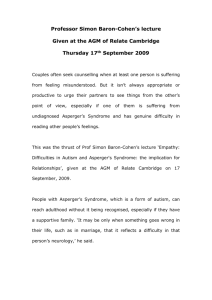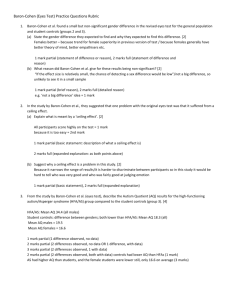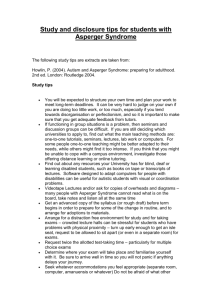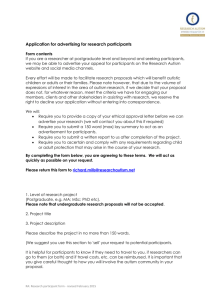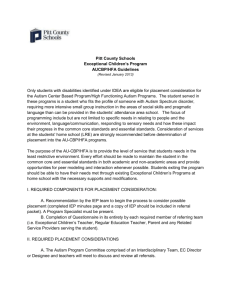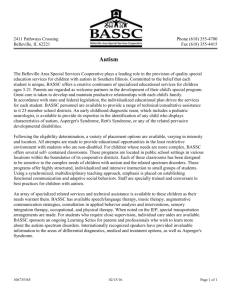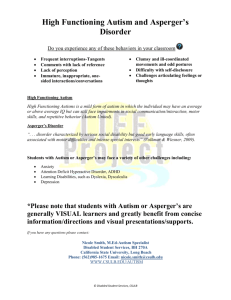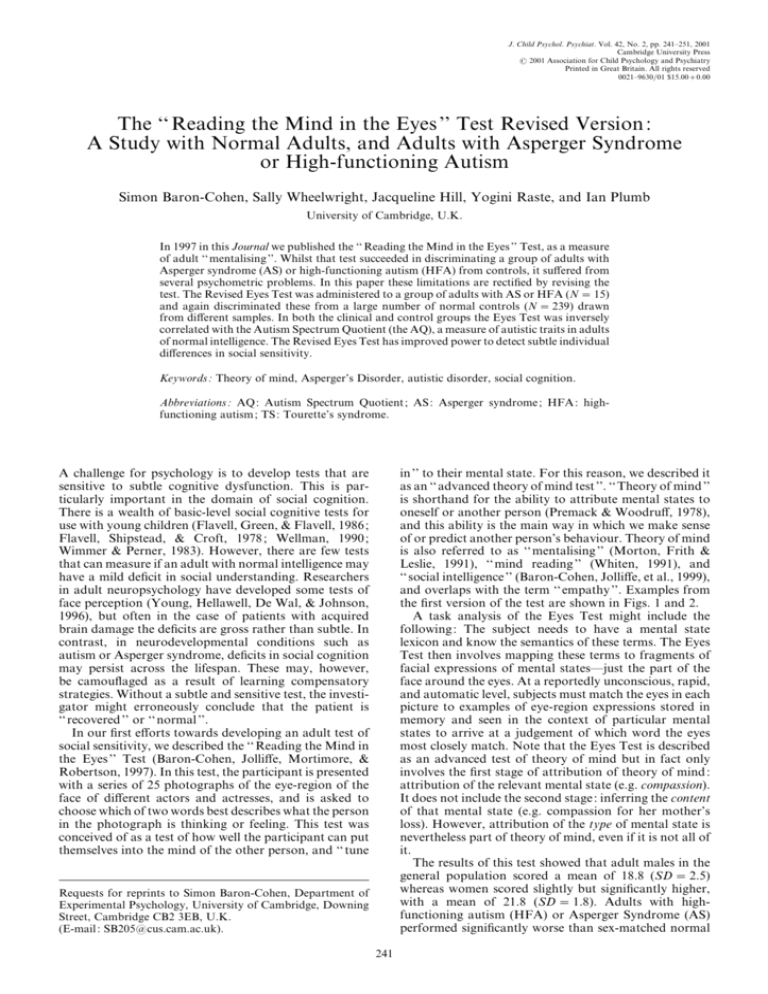
J. Child Psychol. Psychiat. Vol. 42, No. 2, pp. 241–251, 2001
Cambridge University Press
' 2001 Association for Child Psychology and Psychiatry
Printed in Great Britain. All rights reserved
0021–9630\01 $15.00j0.00
The ‘‘ Reading the Mind in the Eyes ’’ Test Revised Version :
A Study with Normal Adults, and Adults with Asperger Syndrome
or High-functioning Autism
Simon Baron-Cohen, Sally Wheelwright, Jacqueline Hill, Yogini Raste, and Ian Plumb
University of Cambridge, U.K.
In 1997 in this Journal we published the ‘‘ Reading the Mind in the Eyes ’’ Test, as a measure
of adult ‘‘ mentalising ’’. Whilst that test succeeded in discriminating a group of adults with
Asperger syndrome (AS) or high-functioning autism (HFA) from controls, it suffered from
several psychometric problems. In this paper these limitations are rectified by revising the
test. The Revised Eyes Test was administered to a group of adults with AS or HFA (N l 15)
and again discriminated these from a large number of normal controls (N l 239) drawn
from different samples. In both the clinical and control groups the Eyes Test was inversely
correlated with the Autism Spectrum Quotient (the AQ), a measure of autistic traits in adults
of normal intelligence. The Revised Eyes Test has improved power to detect subtle individual
differences in social sensitivity.
Keywords : Theory of mind, Asperger’s Disorder, autistic disorder, social cognition.
Abbreviations : AQ : Autism Spectrum Quotient ; AS : Asperger syndrome ; HFA : highfunctioning autism ; TS : Tourette’s syndrome.
A challenge for psychology is to develop tests that are
sensitive to subtle cognitive dysfunction. This is particularly important in the domain of social cognition.
There is a wealth of basic-level social cognitive tests for
use with young children (Flavell, Green, & Flavell, 1986 ;
Flavell, Shipstead, & Croft, 1978 ; Wellman, 1990 ;
Wimmer & Perner, 1983). However, there are few tests
that can measure if an adult with normal intelligence may
have a mild deficit in social understanding. Researchers
in adult neuropsychology have developed some tests of
face perception (Young, Hellawell, De Wal, & Johnson,
1996), but often in the case of patients with acquired
brain damage the deficits are gross rather than subtle. In
contrast, in neurodevelopmental conditions such as
autism or Asperger syndrome, deficits in social cognition
may persist across the lifespan. These may, however,
be camouflaged as a result of learning compensatory
strategies. Without a subtle and sensitive test, the investigator might erroneously conclude that the patient is
‘‘ recovered ’’ or ‘‘ normal ’’.
In our first efforts towards developing an adult test of
social sensitivity, we described the ‘‘ Reading the Mind in
the Eyes ’’ Test (Baron-Cohen, Jolliffe, Mortimore, &
Robertson, 1997). In this test, the participant is presented
with a series of 25 photographs of the eye-region of the
face of different actors and actresses, and is asked to
choose which of two words best describes what the person
in the photograph is thinking or feeling. This test was
conceived of as a test of how well the participant can put
themselves into the mind of the other person, and ‘‘ tune
in ’’ to their mental state. For this reason, we described it
as an ‘‘ advanced theory of mind test ’’. ‘‘ Theory of mind ’’
is shorthand for the ability to attribute mental states to
oneself or another person (Premack & Woodruff, 1978),
and this ability is the main way in which we make sense
of or predict another person’s behaviour. Theory of mind
is also referred to as ‘‘ mentalising ’’ (Morton, Frith &
Leslie, 1991), ‘‘ mind reading ’’ (Whiten, 1991), and
‘‘ social intelligence ’’ (Baron-Cohen, Jolliffe, et al., 1999),
and overlaps with the term ‘‘ empathy ’’. Examples from
the first version of the test are shown in Figs. 1 and 2.
A task analysis of the Eyes Test might include the
following : The subject needs to have a mental state
lexicon and know the semantics of these terms. The Eyes
Test then involves mapping these terms to fragments of
facial expressions of mental states—just the part of the
face around the eyes. At a reportedly unconscious, rapid,
and automatic level, subjects must match the eyes in each
picture to examples of eye-region expressions stored in
memory and seen in the context of particular mental
states to arrive at a judgement of which word the eyes
most closely match. Note that the Eyes Test is described
as an advanced test of theory of mind but in fact only
involves the first stage of attribution of theory of mind :
attribution of the relevant mental state (e.g. compassion).
It does not include the second stage : inferring the content
of that mental state (e.g. compassion for her mother’s
loss). However, attribution of the type of mental state is
nevertheless part of theory of mind, even if it is not all of
it.
The results of this test showed that adult males in the
general population scored a mean of 18n8 (SD l 2n5)
whereas women scored slightly but significantly higher,
with a mean of 21n8 (SD l 1n8). Adults with highfunctioning autism (HFA) or Asperger Syndrome (AS)
performed significantly worse than sex-matched normal
Requests for reprints to Simon Baron-Cohen, Department of
Experimental Psychology, University of Cambridge, Downing
Street, Cambridge CB2 3EB, U.K.
(E-mail : SB205!cus.cam.ac.uk).
241
242
S. BARON-COHEN et al.
Figure 1.
An example of a (male) stimulus used : in the first version word choices were serious (correct) vs. playful. In the revised
version the word choices were serious (correct), ashamed, alarmed, and bewildered.
Figure 2.
A second (female) example from the Eyes Test : in the first version the word choice was reflective (correct) vs. unreflective.
In the revised version the word choice was reflective (correct), aghast, irritated, and impatient.
controls, or adults with a Tourette’s syndrome (TS) (a
different psychiatric condition, and included as an additional control group). Thus, the adults with HFA or AS
scored on average 16n3 out of 25 (SD l 2n9), whereas the
adults with TS scored on average 20n4 out of 25 (SD l
2n6). Although this was only a 4-point difference, it was
significant at the p n01 level. The group with TS did not
differ significantly on this test from the general population.
Thus, we had succeeded in developing a test of social
sensitivity or mind-reading that was able to reveal subtle
mind-reading difficulties in adults with HFA or AS. This
had been predicted on the basis of more basic mindreading deficits in younger children with autism (BaronCohen, 1995). This was also of interest because it
demonstrated that normal adults could judge mental
states from even minimal cues (expressions around the
eyes alone). Having established that the ability to ‘‘ read
the mind in the eyes ’’ was testable, we considered in what
ways the test could be improved.
Problems with the Original Version
of the Test
(1) The first version of the task involved a forced choice
between only two response options (the two words
presented), so chance performance on each trial is p l n5.
Across the test as a whole one would therefore need to
score 17 or above out of 25 to be significantly above
chance (Binomial Test). This meant that the range of
scores in which the test can reveal individual differences
whilst still being above chance is only 9 points (17–25).
This is too narrow. Ideally, a test such as this would have
a wider range, in order to be able to identify individual
differences with greater power.
(2) When the first version of the test was given to
parents of children with AS, they too scored below the
general population level (Baron-Cohen & Hammer,
1997). This had been predicted on the basis that they
might have the ‘‘ broader phenotype ’’ (Bailey et al.,
1995), since one or both of such parents might be carrying
the genes for autism. However, parents scored at a similar
level to people with HFA or AS (fathers scoring on
average 17n3 out of 25 (SD l 1n6), and mothers scoring a
mean of 18n9 (SD l 2n1), even though they did not have
the condition themselves. This highlights that the test has
too narrow a range of scores to be able to distinguish
between someone with the ‘‘ lesser variant ’’\‘‘ broader
phenotype ’’ (e.g., in a first-degree relative of someone
with autism), and someone with the condition itself.
(3) The narrow range of scores that are significantly
above chance on the first test can lead to a score in the
normal range being close to the ceiling of the test. Ceiling
effects are obviously undesirable because one loses power
to detect individual differences.
There are two simple modifications we can make to the
test to remedy these three limitations : increase the
number of items in the test, and increase the number of
response options on each trial. In the revised version of
the test reported in this paper, we have made both of these
modifications : the total number of items (photographs) is
increased from 25 to 36, and the number of response
options (forced-choice words) is increased from 2 to 4 per
trial. This means that chance is p l n25 per trial, and that
‘‘ READING THE MIND IN THE EYES ’’ TEST
one only needs to score 13 or above, out of 36, to be
performing significantly above chance (Binomial Test).
In effect, this provides a bigger window of 24 points (from
13–36) in which to be able to reveal individual differences
in ability on this test. It also decreases the risk of normal
performance approaching the ceiling of the test.
(4) The first version of the test included both basic and
complex mental states, and so contained some items that
were too easy, and which therefore risked producing
ceiling effects. Basic emotions are happy, sad, angry,
afraid, and disgust. They are basic because they are
recognised universally ; because they can be recognised
purely as emotions, without the need to attribute a belief
to the person ; and because they are recognised even by
very young normally developing children (Ekman &
Friesen, 1971, Harris, 1991 ; Walker, 1982). Complex
mental states in contrast involve attribution of a belief or
intention—a cognitive mental state—to the person. In the
revised version of the test we limited the items to complex
mental states so as to make the task that much more
challenging, and in this way increasing the likelihood of
obtaining a greater range of performance in a random
sample of adults.
(5) In the original version, there were some items that
could be solved simply by checking the gaze direction of
the face. The words for such items were ‘‘ noticing ’’ or
‘‘ ignoring ’’, etc., (mental states linked to perception),
such that gaze-direction might be all that a participant
needed to attend to in order to arrive at the correct
answer. This could be too easy a clue for someone with a
subtle mind-reading difficulty. These are therefore
excluded in the revised version of the test.
(6) The original version had more female faces than
male faces, and it was unclear if this may have biased the
test in some way. In the revised version of the test, this
was carefully controlled by having an equal number of
male and female faces in the photographs. The advantage
of this was that it allowed a control condition—judging
gender from the eyes—to be closely matched to the
experimental condition—judging mental states from the
eyes.
(7) In the original version of the test the target word
and its foil were always semantic opposites (e.g., concerned vs. unconcerned, or sympathetic vs. unsympathetic), again making the test too easy. The test essentially
was asking the participant to distinguish chalk from
cheese, or black from white—in this case, asking them to
distinguish between mental states of opposite emotional
valence (positive vs. negative). In the revised version of
the test we have again increased the level of difficulty by
ensuring that as far as possible the three foil words have
the same emotional valence as the target word. For
example, if the target word was ‘‘ serious ’’, the foil words
might be ‘‘ ashamed ’’, ‘‘ alarmed ’’, and ‘‘ bewildered ’’.
This effectively means that a person has to distinguish the
correct target word from three close imposters, on each
trial. As such, we are testing the ability to distinguish
shades of gray, or different types of cheese, as it were, so
as to add to the challenging nature of the test, thereby
maximising the possibility of revealing subtle individual
differences. Figures 1 and 2 show two examples of pictures
taken from the original test but with the new choice of
four words with each.
(8) Finally, given that the Eyes Test involves mapping
a word to a picture, it is unclear if comprehension
problems with the words themselves might have contributed to an individual’s score. This is particularly a
243
concern with a group of patients with HFA in whom
there will have been language delay. In the revised version
of this test, we rectified this problem by including a
glossary of all the mental state terms, which subjects were
encouraged to consult in any case where they were unsure
of a word.
The study below reports data from the revised version
of this test, and had several additional aims. (1) To test a
group of adults with AS or HFA on the revised version of
the test. This was in order to check if the deficit in this
group of patients that had been found on the original
version (Baron-Cohen, Jolliffe, et al., 1997) and related
tests (Baron-Cohen, Wheelwright, & Jolliffe, 1997) could
be replicated. (2) To test if in a sample of normal adults,
an inverse correlation would be found between performance on the Eyes Test (Revised) and the Autism
Spectrum Quotient (AQ) (Baron-Cohen & Wheelwright,
in press). The AQ measures the degree to which any
individual (adult) of normal IQ possesses traits related to
the autistic ‘‘ spectrum ’’ (Wing, 1988). The AQ is a selfreport questionnaire. Scores range from 0–50, and the
higher the score, the more autistic traits a person possesses. (3) To test if the sex difference (female superiority)
found on the first version of the test (Baron-Cohen,
Jolliffe, et al., 1997) replicated.
Method
Subjects
Table 1 shows the four groups of subjects tested.
Group 1 comprised adults with AS or HFA (N l 15, all
male). They were recruited via adverts in the U.K. National
Autistic Society magazine, or equivalent support groups. They
had all been diagnosed in specialist centres using established
criteria (American Psychiatric Association, 1994 ; World Health
Organisation, 1994). They spanned an equivalent range of
socioeconomic classes and educational levels as seen in Group
2. They were all given the short WAIS-R (Wechsler, 1939)
comprising the Block Design, Vocabulary, Similarities, and
Picture Completion, and all scored in the normal range (mean
l 115, SD l 16n1).
Group 2 comprised normal adults (N l 122) drawn from
adult community and education classes in Exeter, or from
public library users in Cambridge. They had a broad mix of daytime occupations ranging from unemployment through manual
and clerical workers, to professionals. They also had a broad
mix of educational level, some having no education beyond
secondary school, others having either occupationally related
training, or college degrees. Data on age was available for N l
88 of these.
Group 3 comprised normal adult students (N l 103, 53 male,
50 female) all studying for undergraduate degrees in Cambridge
University (71 in science, 32 in other subjects). Since this
university has very stringent entrance requirements (typically
three grade As at Advanced Level [school leaving] examination),
this group is not representative of the general population and
they can be assumed to have high IQ.
Group 4 comprised randomly selected individuals in the
general population (N l 14) who were IQ matched with Group
1 (mean l 116, SD l 6n4). Groups 1 and 4 did not differ
significantly or IQ, or on age. See Table 1.
Procedure
Subjects in all four groups were tested on the revised adult
Eyes Test, as described earlier. This was individually administered in a quiet room in Cambridge or Exeter. Subjects in the
AS\HFA group were also asked to judge the gender of each
244
S. BARON-COHEN et al.
Table 1
Subject Characteristics
Chronological age
Group 1
AS\HFA adults
Group 2
General population controlsa
Group 3
Students
Group 4
IQ-matched controls
a
N
Mean
SD
Mean
SD
15
29n7
14n5
115
16n1
88
46n5
16n9
—
—
103
20n8
0n8
—
—
14
28n0
9n0
116
6n4
N l 122 for Eyes Test.
Table 2
Percentage of Subjects in Groups 2 and 3 Combined, Who
Chose Each Word on Each Item
Item
1
2
3
4
5
6
7
8
9
10
11
12
13
14
15
16
17
18
19
20
21
22
23
24
25
26
27
28
29
30
31
32
33
34
35
36
37
38
39
40
IQ
Target
Foil 1
Foil 2
Foil 3
31n6
53n1
78n7
82n1
84n9
79n6
79n9
79n5
72n9
74n7
83n6
48n4
68n4
73n8
85n8
72n9
86n7
76n0
79n6
63n4
68n3
64n4
88n0
77n3
84n9
80n9
75n6
64n9
72n9
64n4
65n8
71n9
90n2
52n0
60n4
65n8
79n1
73n3
81n3
60n0
1n8
4n0
4n9
5n4
4n0
1n3
7n6
3n6
6n7
12n9
4n9
34n7
20n4
3n1
6n7
7n1
6n2
1n8
9n3
18n8
10n3
10n2
5n3
12n4
1n3
0n4
8n0
5n8
2n7
1n8
4n9
16n5
2n2
16n4
10n2
6n7
0n9
10n7
0n9
3n1
26n2
5n8
12n0
4n9
2n2
8n0
10n3
13n8
14n7
8n9
8n9
13n3
8n4
12n0
5n3
4n0
5n3
13n3
4n0
16n1
4n5
17n3
6n7
8n9
3n6
4n0
4n0
21n8
4n9
21n8
22n2
0n9
4n4
11n6
23n6
23n1
16n4
8n9
2n2
26n7
40n4
37n1
4n4
7n6
8n9
11n1
2n2
3n1
5n8
3n6
2n7
3n6
2n7
11n1
2n2
16n0
1n8
8n9
7n1
1n8
17n0
8n0
0n0
1n3
10n2
14n7
12n4
7n6
19n6
12n0
7n1
10n7
3n1
20n0
5n8
4n4
3n6
7n1
15n6
10n2
person in each photo, as a control task, given anticipated
impairments on mental state recognition. Normal adults were
found to be at ceiling on the gender recognition task during
piloting so, to save time, were not required to do this task. In
addition, subjects in Groups 1, 3, and 4 completed the AQ
(Baron-Cohen & Wheelwright, in press). Finally, subjects were
asked at the outset to read through the glossary (see Appendix
B) and indicate any word meanings they were unsure of. They
were then encouraged to read these particular meanings and
were told that they could return to this glossary at any point
during the testing.
Eyes Test Development
Target words and foils were generated by the first two authors
and were then piloted on groups of eight judges (four male, four
female). The criterion adopted was that at least five out of eight
judges agreed that the target word was the most suitable
description for each stimulus and that no more than two judges
picked any single foil. Items that failed to meet this criterion had
new target words, foils, or both generated and were then repiloted with successive groups of judges until the criterion was
met for all items.
The data from Groups 2 and 3 did not differ from each other,
so the results were combined, creating a sample of N l 225.
Table 2 shows the results of an item analysis on this combined
group. New criteria were applied to these data : at least 50 % of
subjects had to select the target word and no more than 25 %
could select any one of the foils. These criteria were arbitrarily
selected but with the aim of checking that a clear majority of the
normal controls selected the target word and that this was
selected at least twice as often as any foil. Items 1, 2, 12 and 40
failed to meet these criteria and were therefore dropped.
Subsequent analyses were carried out using the 36 items. Thus
target words were established on the basis of consensus from a
large population, since there is no objective method for
identifying the underlying mental state from an expression. The
complete list of target mental state words (in italic) and their
foils are shown in Appendix A. The glossary of mental state
terms is shown in Appendix B.
Predictions
Based on the previous studies we predicted that :
(1) The AS\HFA group would score significantly lower on
the mental state judgements on the Eyes Test, but be
unimpaired on the gender control judgements.
(2) The AS\HFA group would score significantly higher in
the AQ.
(3) Females in the ‘‘ normal ’’ groups (2 and 3) would score
higher than males on the Eyes Test.
(4) Males in the ‘‘ normal ’’ group (3) would score higher than
females on the AQ.
(5) Scores on the AQ and the Eyes Test would be inversely
correlated.
Results
Subjects in the four groups did not differ in the number
of words in the glossary that they were unsure of, and in
all subjects, the number of words checked never exceeded
‘‘ READING THE MIND IN THE EYES ’’ TEST
245
Table 3
Performance on the Revised Eyes Test and AQ
AQ
Eyes Test
Group 1
AS\HFA adults
All
Group 2
General population controls
All
Males
Females
Group 3
Students
All
Males
Females
Group 4
IQ matched controls
All
a
b
c
d
N
Mean
SD
Mean
SD
15
21n9
6n6
34n4a
6n0
122
55
67
26n2
26n0
26n4
3n6
4n2
3n2
—
—
—
—
—
—
103
53
50
28n0
27n3
28n6
3n5
3n7
3n2
18n3b
19n5c
16n6d
6n6
6n7
6n1
14
30n9
3n0
18n9
2n9
N l 14, due to 1 unreturned AQ.
N l 79, due to 24 unreturned AQs.
N l 47, due to 6 unreturned AQs.
N l 32, due to 18 unreturned AQs.
Figure 3.
Distribution of Eyes Test scores in Groups 2 and 3.
two. Table 3 shows the means and standard deviations on
the Revised Eyes Task for each of the four groups, and
the results of the AQ for Groups 1, 3, and 4 only. A oneway ANOVA comparing the four groups on the Revised
Eyes Task revealed that there was a significant main effect
of group, F(3, 250) l 17n87, p l n0001. Further examination of this result using Scheffe! ’s tests indicated that,
as predicted, Group 1 performed significantly worse than
the other three groups, who did not differ from each
other. This is shown graphically in Fig. 3. Sex differences
were examined in Groups 2 and 3, using an ANOVA of
GroupiSex. The sex difference approached significance,
F(1, 224) l 3n38, p l n067, with females scoring higher
than males, whilst the interaction was insignificant,
F(1, 224) l 0n79, p l n376. Separate group item analyses
are shown in Table 4. All subjects with AS\HFA scored
33 or above out of 36 on the gender recognition control
task. There were no within-group differences in Group 3
(students) according to subject studied, F(1, 99) l 1n39,
p l n24.
On the AQ, as expected, Group 1 scored significantly
higher than Groups 3 and 4 : one-way ANOVA of group,
F(2, 103) l 23n4, p l n00001 ; Scheffe! ’s tests indicated
Group 1 scored significantly higher at the n05 level than
Groups 3 and 4, for which there was no difference. The
predicted sex difference on the AQ (males scoring higher
246
S. BARON-COHEN et al.
Table 4
Item Analysis of the Eyes Test (Including Only the 36 Retained Items), Showing the
Percentage of Each Group Passing Each Item
Item
1
2
3
4
5
6
7
8
9
10
11
12
13
14
15
16
17
18
19
20
21
22
23
24
25
26
27
28
29
30
31
32
33
34
35
36
Group 1
AS\HFA
adults
(N l 15)
Group 2
General population
controls
(N l 122)
Group 3
Students
(N l 103)
Group 4
IQ-matched
controls
(N l 14)
60n0
73n3
66n7
33n3
66n7
86n7
46n7
60n0
80n0
66n7
46n7
53n3
60n0
73n3
66n7
80n0
53n3
46n7
66n7
86n7
53n3
60n0
53n3
80n0
60n0
53n3
46n7
40n0
80n0
53n3
53n3
46n7
66n7
60n0
46n7
66n7
85n2
78n7
86n1
73n0
77n0
80n3
68n0
67n2
77n0
73n0
68n0
87n7
69n7
80n3
69n7
77n0
65n6
58n2
69n7
88n5
73n8
79n5
77n9
73n8
71n3
65n6
65n6
66n4
77n9
91n0
51n6
50n0
58n2
77n0
65n6
76n2
70n9
85n4
83n5
87n4
82n5
77n7
78n6
83n5
91n3
63n1
80n6
83n5
76n7
94n2
83n5
82n5
60n2
79n6
58n3
87n4
81n6
91n3
84n5
77n7
57n3
81n6
63n1
65n0
64n1
89n3
52n4
72n8
74n8
81n6
82n5
87n4
100n0
100n0
100n0
78n6
85n7
85n7
92n9
78n6
85n7
85n7
92n9
92n9
78n6
100n0
85n7
78n6
85n7
71n4
71n4
92n9
85n7
85n7
85n7
92n9
71n4
100n0
64n3
57n1
92n9
85n7
85n7
78n6
85n7
85n7
92n9
92n9
than females) in Group 3 was also found (t l 1n97, p l
n03 for one-tailed significance). Finally, the correlation
between AQ score, IQ score, and Eyes Test score was
computed. Combining the groups, there was no correlation between the Eyes Test and IQ (r l n09, p l n6)
or between the AQ and IQ (r l n05, p l n77). The AQ
and Eyes Test were, as expected, inversely correlated
(r lkn53, p l n004). This was true for all three groups
where both measures were used. In the student group, the
Eyes Test was inversely correlated with the social skills
category (r l n27, p l n015) and the communication
category (r l n25, p l n027).
Discussion
This study reports normative data on the Revised Eyes
Test for adults. The modifications were designed to
render this test a more sensitive measure of adult social
intelligence. As was hoped, the modifications from the
original version led to normal performance being significantly below ceiling. This is important if the test is to do
more than discriminate extreme performance and instead
detect meaningful individual differences. This study
replicated the earlier finding that adults with AS or HFA
are significantly impaired on such tests, whereas they are
not impaired on the gender recognition control test
(Baron-Cohen, Jolliffe, et al., 1997 ; Baron-Cohen,
Wheelwright, et al., 1997). This therefore validates it as a
useful test with which to identify subtle impairments in
social intelligence in otherwise normally intelligent adults.
In a series of single case studies we have also found that
this test distinguishes very high-functioning adults with
AS\HFA from controls (Baron-Cohen, Wheelwright,
Stone, & Rutherford, 1999). The Revised Eyes Test may
be relevant to clinical groups beyond those on the autistic
spectrum (e.g., brain-damaged patients following
amygdalectomy or prefrontal cortical lesions). The test
has recently been used with these groups (Stone, BaronCohen, & Knight, 1999 ; Stone, Baron-Cohen, Young, &
Calder, 1998). We have recently developed a child version
of this test, reported separately (Baron-Cohen, Wheelwright, Spong, Scahill, & Lawson, in press). The adult
Eyes Test has been used during fMRI, revealing amygdala
activity in the normal (but not in the autistic) brain
(Baron-Cohen, Ring, et al., 1999).
‘‘ READING THE MIND IN THE EYES ’’ TEST
In the present study, among the general population
controls and student group, there was a trend towards a
sex difference (female superiority) (p l n07). This echoes
the sex difference found with the previous version of this
test. One possible reason why the sex difference did not
reach significance with the new test is that if the effect size
is relatively small, the chance of detecting a sex difference
would be low. There was no significant correlation
between IQ and the Eyes Test, suggesting this is independent of general (nonsocial) intelligence.
Performance on the Revised Eyes Test was inversely
correlated with performance on the Autism Spectrum
Quotient (AQ), suggesting that both measure degrees of
autistic traits across the notional spectrum (Wing, 1988).
The AQ is not diagnostic but may serve as a useful
instrument for quantifying the extent of an individual’s
‘‘ caseness ’’ in terms of AS\HFA, measuring personality
traits. The present results confirm our earlier finding that
adults with HFA or AS score significantly higher on the
AQ than do general population controls.
A criticism of the Revised Eyes Test might be that, even
with the new modifications, the stimuli are static, whereas
the real world never is. Future studies might usefully
employ dynamic stimuli of eye expressions. Static stimuli,
however, make the test quick and easy to use, since it can
be administered as a ‘‘ pencil and paper ’’ test. In our
laboratory, we are also experimenting with computerpresentation of the Eyes stimuli so as to record response
time in subjects’ judgements of the most appropriate
mental state term to match each picture. Such speed of
processing approaches may be a fruitful way to explore
individual differences on this task. However, it is clear
that even a nonautomated format is sufficient to reveal
group differences. The Eyes test stands as an example of
how experimental methods can be applied to the social
domain.
Acknowledgements—SBC and SW were supported by the
MRC and the McDonnell Pew Foundation during the period of
this work. IP and YR submitted the normative data, which they
collected, as part of their final year project for the degree of BSc
in Psychology, University of Cambridge. JH collected the
normative data as part of her MSc in Psychological Research
Methods at the University of Exeter.
References
American Psychiatric Association (1994). DSM-IV Diagnostic
and statistical manual of mental disorders (4th ed). Washington, DC : Author.
Bailey, T., Le Couteur, A., Gottesman, I., Bolton, P., Simonoff,
E., Yuzda, E., & Rutter, M. (1995). Autism as a strongly
genetic disorder : Evidence from a British twin study. Psychological Medicine, 25, 63–77.
Baron-Cohen, S. (1995). Mindblindness : An essay on autism and
theory of mind. Boston : MIT Press\Bradford Books.
Baron-Cohen, S., & Hammer, J. (1997). Parents of children
with Asperger syndrome : What is the cognitive phenotype ?
Journal of Cognitive Neuroscience, 9, 548–554.
Baron-Cohen, S., Jolliffe, T., Mortimore, C., & Robertson, M.
(1997). Another advanced test of theory of mind : Evidence
from very high-functioning adults with autism or Asperger
247
Syndrome. Journal of Child Psychology and Psychiatry, 38,
813–822.
Baron-Cohen, S., Ring, H., Wheelwright, S., Bullmore, E.,
Brammer, M., Simmons, A., & Williams, S. (1999). Social
intelligence in the normal and autistic brain : An fMRI study.
European Journal of Neuroscience, 11, 1891–1898.
Baron-Cohen, S., & Wheelwright, S. (in press). The AutismSpectrum Quotient (AQ) : Evidence from Asperger
syndrome\high-functioning autism, males and females,
scientists and mathematicians. Journal of Autism and Developmental Disorders.
Baron-Cohen, S., Wheelwright, S., & Jolliffe, T. (1997). Is there
a ‘‘ language of the eyes ’’ ? Evidence from normal adults and
adults with autism or Asperger syndrome. Visual Cognition,
4, 311–331.
Baron-Cohen, S., Wheelwright, S., Spong, A., Scahill, V., &
Lawson, J. (in press). Are intuitive physics and intuitive
psychology independent ? A test with children with Asperger
syndrome. Journal of Developmental and Learning Disorders.
Baron-Cohen, S., Wheelwright, S., Stone, V., & Rutherford, M.
(1999). A mathematician, a physicist, and a computer scientist
with Asperger syndrome : Performance on folk psychology
and folk physics test. Neurocase, 5, 475–483.
Ekman, P., & Friesen, W. (1971). Constants across cultures in
the face and emotion. Journal of Personality and Social
Psychology, 17, 124–129.
Flavell, J. H., Green, E. R. & Flavell, E. R. (1986). Development of knowledge about the appearance-reality distinction. Society for Research in Child Development, 51.
Flavell, J., Shipstead, S., & Croft, K. (1978). Young children’s
knowledge about visual perception : Hiding objects from
others. Child Development, 49, 1208–1211.
Morton, J., Frith, U., & Leslie, A. (1991). The cognitive basis of
a biological disorder : Autism. Trends in Neurosciences, 14,
434–438.
Premack, D., & Woodruff, G. (1978). Does the chimpanzee
have a ‘‘ theory of mind ’’ ? Behaviour and Brain Sciences, 4,
515–526.
Stone, V., Baron-Cohen, S., & Knight, K. (1999). Frontal lobe
contributions to theory of mind. Journal of Cognitive Neuroscience, 10, 640–656.
Stone, V., Baron-Cohen, S., Young, A., & Calder, A. (1998).
Patients with amygdalectomy show impairments in theory of
mind. Cambridge : University of Cambridge.
Walker, A. S. (1982). Intermodal perception of expressive
behaviours by human infants. Journal of Experimental Child
Psychology, 33, 514–535.
Wechsler, D. (1939). The measurement of adult intelligence.
Baltimore, MD : Williams & Wilkins.
Wellman, H. (1990). Children’s theories of mind. Cambridge,
MA : MIT Press.
Whiten, A. (1991). Natural theories of mind. Oxford : Basil
Blackwell.
Wimmer, H., & Perner, J. (1983). Beliefs about beliefs :
Representation and constraining function of wrong beliefs in
young children’s understanding of deception. Cognition, 13,
103–128.
Wing, L. (1988). The autistic continuum. In L. Wing (Ed.),
Aspects of autism : Biological research. London : Gaskell\
Royal College of Psychiatrists.
World Health Organisation. (1994). International classification
of diseases (10th ed.). Geneva : Author.
Young, A., Hellawell, D., De Wal, C., & Johnson, M. (1996).
Facial expression processing after amygdalectomy. Neuropsychologia, 34, 31–39.
Manuscript accepted 30 June 2000
248
S. BARON-COHEN et al.
Appendix A
List of Target Mental State Terms for Each Item (in Italic) and Their
Distractors
PIa jealous
1 playful
2 terrified
3 joking
4 joking
5 irritated
6 aghast
7 apologetic
8 despondent
9 annoyed
10 cautious
11 terrified
12 indifferent
13 decisive
14 irritated
15 contemplative
16 irritated
17 doubtful
18 decisive
19 arrogant
20 dominant
21 embarrassed
22 preoccupied
23 contented
24 pensive
25 panicked
26 alarmed
27 joking
28 interested
29 impatient
30 grateful
31 ashamed
32 serious
33 embarrassed
34 aghast
35 puzzled
36 ashamed
aPI :
panicked
comforting
upset
flustered
insisting
sarcastic
fantasizing
friendly
relieved
hostile
insisting
amused
embarrassed
anticipating
disappointed
flustered
thoughtful
affectionate
amused
grateful
friendly
fantasizing
grateful
apologetic
irritated
incredulous
shy
cautious
joking
aghast
flirtatious
confident
ashamed
guilty
baffled
nervous
nervous
arrogant
irritated
arrogant
desire
amused
worried
impatient
uneasy
shy
horrified
bored
regretful
sceptical
threatening
depressed
encouraging
encouraging
playful
aghast
sarcastic
guilty
confused
insisting
defiant
excited
despondent
hostile
arrogant
affectionate
irritated
hostile
joking
bewildered
fantasizing
distrustful
insisting
suspicious
hateful
bored
annoyed
convinced
relaxed
friendly
alarmed
dispirited
excited
preoccupied
aghast
flirtatious
dispirited
shy
accusing
amused
sympathetic
aghast
bored
tentative
horrified
panicked
imploring
curious
hostile
interested
anxious
reassuring
contented
reflective
disappointed
dispirited
alarmed
concerned
terrified
contemplative
indecisive
practice item.
Appendix B
Glossary for Adult Eyes Test
ACCUSING
AFFECTIONATE
AGHAST
ALARMED
AMUSED
ANNOYED
ANTICIPATING
ANXIOUS
APOLOGETIC
ARROGANT
ASHAMED
blaming
The policeman was accusing the man of stealing a wallet.
showing fondness toward someone
Most mothers are affectionate to their babies by giving them lots of kisses and cuddles.
horrified, astonished, alarmed
Jane was aghast when she discovered her house had been burgled.
fearful, worried, filled with anxiety
Claire was alarmed when she thought she was being followed home.
finding something funny
I was amused by a funny joke someone told me.
irritated, displeased
Jack was annoyed when he found out he had missed the last bus home.
expecting
At the start of the football match, the fans were anticipating a quick goal.
worried, tense, uneasy
The student was feeling anxious before taking her final exams.
feeling sorry
The waiter was very apologetic when he spilt soup all over the customer.
conceited, self-important, having a big opinion of oneself
The arrogant man thought he knew more about politics than everyone else in the room.
overcome with shame or guilt
The boy felt ashamed when his mother discovered him stealing money from her purse.
‘‘ READING THE MIND IN THE EYES ’’ TEST
Appendix B (cont.)
ASSERTIVE
confident, dominant, sure of oneself
The assertive woman demanded that the shop give her a refund.
BAFFLED
confused, puzzled, dumfounded
The detectives were completely baffled by the murder case.
BEWILDERED
utterly confused, puzzled, dazed
The child was bewildered when visiting the big city for the first time.
CAUTIOUS
careful, wary
Sarah was always a bit cautious when talking to someone she did not know.
COMFORTING
consoling, compassionate
The nurse was comforting the wounded soldier.
CONCERNED
worried, troubled
The doctor was concerned when his patient took a turn for the worse.
CONFIDENT
self-assured, believing in oneself
The tennis player was feeling very confident about winning his match.
CONFUSED
puzzled, perplexed
Lizzie was so confused by the directions given to her, she got lost.
CONTEMPLATIVE reflective, thoughtful, considering
John was in a contemplative mood on the eve of his 60th birthday.
CONTENTED
satisfied
After a nice walk and a good meal, David felt very contented.
CONVINCED
certain, absolutely positive
Richard was convinced he had come to the right decision.
CURIOUS
inquisitive, inquiring, prying
Louise was curious about the strange-shaped parcel.
DECIDING
making your mind up
The man was deciding who to vote for in the election.
DECISIVE
already made your mind up
Jane looked very decisive as she walked into the polling station.
DEFIANT
insolent, bold, don’t care what anyone else thinks
The animal protester remained defiant even after being sent to prison.
DEPRESSED
miserable
George was depressed when he didn’t receive any birthday cards.
DESIRE
passion, lust, longing for
Kate had a strong desire for chocolate.
DESPONDENT
gloomy, despairing, without hope
Gary was despondent when he did not get the job he wanted.
DISAPPOINTED
displeased, disgruntled
Manchester United fans were disappointed not to win the Championship.
DISPIRITED
glum, miserable, low
Adam was dispirited when he failed his exams.
DISTRUSTFUL
suspicious, doubtful, wary
The old woman was distrustful of the stranger at her door.
DOMINANT
commanding, bossy
The sergeant major looked dominant as he inspected the new recruits.
DOUBTFUL
dubious, suspicious, not really believing
Mary was doubtful that her son was telling the truth.
DUBIOUS
doubtful, suspicious
Peter was dubious when offered a surprisingly cheap television in a pub.
EAGER
keen
On Christmas morning, the children were eager to open their presents.
EARNEST
having a serious intention
Harry was very earnest about his religious beliefs.
EMBARRASSED
ashamed
After forgetting a colleague’s name, Jenny felt very embarrassed.
ENCOURAGING hopeful, heartening, supporting
All the parents were encouraging their children in the school sports day.
ENTERTAINED
absorbed and amused or pleased by something
I was very entertained by the magician.
ENTHUSIASTIC
very eager, keen
Susan felt very enthusiastic about her new fitness plan.
249
250
S. BARON-COHEN et al.
Appendix B (cont.)
FANTASIZING
FASCINATED
FEARFUL
FLIRTATIOUS
FLUSTERED
FRIENDLY
GRATEFUL
GUILTY
HATEFUL
HOPEFUL
HORRIFIED
HOSTILE
IMPATIENT
IMPLORING
INCREDULOUS
INDECISIVE
INDIFFERENT
INSISTING
INSULTING
INTERESTED
INTRIGUED
IRRITATED
JEALOUS
JOKING
NERVOUS
OFFENDED
PANICKED
PENSIVE
PERPLEXED
PLAYFUL
daydreaming
Emma was fantasizing about being a film star.
captivated, really interested
At the seaside, the children were fascinated by the creatures in the rock pools.
terrified, worried
In the dark streets, the women felt fearful.
brazen, saucy, teasing, playful
Connie was accused of being flirtatious when she winked at a stranger at a party.
confused, nervous and upset
Sarah felt a bit flustered when she realised how late she was for the meeting and that she had
forgotten an important document.
sociable, amiable
The friendly girl showed the tourists the way to the town centre.
thankful
Kelly was very grateful for the kindness shown by the stranger.
feeling sorry for doing something wrong
Charlie felt guilty about having an affair.
showing intense dislike
The two sisters were hateful to each other and always fighting.
optimistic
Larry was hopeful that the post would bring good news.
terrified, appalled
The man was horrified to discover that his new wife was already married.
unfriendly
The two neighbours were hostile towards each other because of an argument about loud music.
restless, wanting something to happen soon
Jane grew increasingly impatient as she waited for her friend who was already 20 minutes late.
begging, pleading
Nicola looked imploring as she tried to persuade her dad to lend her the car.
not believing
Simon was incredulous when he heard that he had won the lottery.
unsure, hesitant, unable to make your mind up
Tammy was so indecisive that she couldn’t even decide what to have for lunch.
disinterested, unresponsive, don’t care
Terry was completely indifferent as to whether they went to the cinema or the pub.
demanding, persisting, maintaining
After a work outing, Frank was insisting he paid the bill for everyone.
rude, offensive
The football crowd was insulting the referee after he gave a penalty.
inquiring, curious
After seeing Jurassic Park, Huge grew very interested in dinosaurs.
very curious, very interested
A mystery phone call intrigued Zoe.
exasperated, annoyed
Frances was irritated by all the junk mail she received.
envious
Tony was jealous of all the taller, better-looking boys in his class.
being funny, playful
Gary was always joking with his friends.
apprehensive, tense, worried
Just before her job interview, Alice felt very nervous.
insulted, wounded, having hurt feelings
When someone made a joke about her weight, Martha felt very offended.
distraught, feeling of terror or anxiety
On waking to find the house on fire, the whole family were panicked.
thinking about something slightly worrying
Susie looked pensive on the way to meeting her boyfriend’s parents for the first time.
bewildered, puzzled, confused
Frank was perplexed by the disappearance of his garden gnomes.
full of high spirits and fun
Neil was feeling playful at his birthday party.
‘‘ READING THE MIND IN THE EYES ’’ TEST
Appendix B (cont.)
PREOCCUPIED
PUZZLED
REASSURING
REFLECTIVE
REGRETFUL
RELAXED
RELIEVED
RESENTFUL
SARCASTIC
SATISFIED
SCEPTICAL
SERIOUS
STERN
SUSPICIOUS
SYMPATHETIC
TENTATIVE
TERRIFIED
THOUGHTFUL
THREATENING
UNEASY
UPSET
WORRIED
absorbed, engrossed in one’s own thoughts
Worrying about her mother’s illness made Debbie preoccupied at work
perplexed, bewildered, confused
After doing the crossword for an hour, June was still puzzled by one clue.
supporting, encouraging, giving someone confidence
Andy tried to look reassuring as he told his wife that her new dress did suit her.
contemplative, thoughtful
George was in a reflective mood as he thought about what he’d done with his life.
sorry
Lee was always regretful that he had never travelled when he was younger.
taking it easy, calm, carefree
On holiday, Pam felt happy and relaxed.
freed from worry or anxiety
At the restaurant, Ray was relieved to find he had not forgotten his wallet.
bitter, hostile
The businessman felt very resentful towards his younger colleague who had been promoted above
him.
cynical, mocking, scornful
The comedian made a sarcastic comment when someone came into the theatre late.
content, fulfilled
Steve felt very satisfied after he had got his new flat just how he wanted it.
doubtful, suspicious, mistrusting
Patrick looked sceptical as someone read out his horoscope to him.
solemn, grave
The bank manager looked serious as he refused Nigel an overdraft.
severe, strict, firm
The teacher looked very stern as he told the class off.
disbelieving, suspecting, doubting
After Sam had lost his wallet for the second time at work, he grew suspicious of one of his
colleagues.
kind, compassionate
The nurse looked sympathetic as she told the patient the bad news.
hesitant, uncertain, cautious
Andrew felt a bit tentative as he went into the room full of strangers.
alarmed, fearful
The boy was terrified when he thought he saw a ghost.
thinking about something
Phil looked thoughtful as he sat waiting for the girlfriend he was about to finish with.
menacing, intimidating
The large, drunk man was acting in a very threatening way.
unsettled, apprehensive, troubled
Karen felt slightly uneasy about accepting a lift from the man she had only met that day.
agitated, worried, uneasy
The man was very upset when his mother died.
anxious, fretful, troubled
When her cat went missing, the girl was very worried.
251

